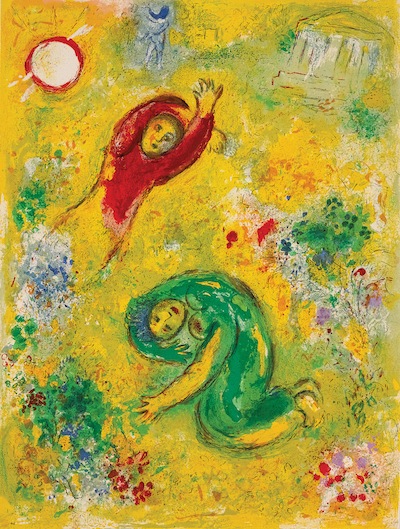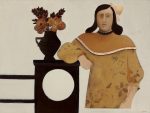“Girl with Flower” by Esther Warkov, 1964, acrylic on canvas. (WAG collection; gift of Arthur B.C. Drache, QC, G-98-296; photo by Leif Norman)
Russian-born Jewish artist Marc Chagall (1887-1985) was a modernism pioneer. So much so that Pablo Picasso proclaimed that, when Henri Matisse dies, “Chagall will be the only painter left who understands what color really is.”
In the early 1920s, Chagall left Russia for Paris. In 1941, he escaped France and reached safe haven in New York. He returned to France a few years after the end of the Second World War.
“This sense of displacement Chagall feels throughout his life is reflected in his works, often featuring characters who hover over the earth…. Even if they’re lying down, they’re sort of levitating,” said Andrew Kear, Winnipeg Art Gallery (WAG) historical Canadian art curator. “There’s a sense of rootlessness to his work that’s quite interesting, and it’s reflected in his later work, too. By the 1940s – an important time for Chagall – he loses his first wife, his first love really, Bella, to cancer in or around 1944 … and is absolutely distraught.”
In an exhibition overseen by Kear, WAG has brought in the exhibit Chagall: Daphnis & Chloé from the National Gallery of Canada (NGC). It will be in Winnipeg until Sept. 11.
The exhibit, the latest NGC-WAG collaboration, features 42 lithographs, widely considered the crowning achievement of the artist’s career as a printmaker. The series depicts the semi-erotic tale written by the ancient Greek poet, Longus. Through fanciful compositions and bright hues, Chagall expresses the pastoral idylls of the young goatherd Daphnis and the young shepherdess Chloé on the island of Lesbos.
At WAG, there is also a complementary mini-exhibit called Chagall & Winnipeg, which tells the little-known tale of friendship between Chagall and former WAG director Dr. Ferdinand Eckhardt through letters, photographs and works of art.

“In addition to sketching out the story, this second exhibition … include[s] a number of paintings by Chagall that we’ve borrowed from the NGC and the Minneapolis Institute of Art,” said Kear.
In addition to these two Chagall exhibits, WAG is featuring Winnipeg Jewish artist Esther Warkov in an exhibit that includes her work from the 1960s to the 1980s. It runs until Oct. 16.
Born in 1941, Warkov did not do that well in school, but there was a lot of family pressure to succeed. By chance, she discovered jewelry making as a young teen, which, in turn, exposed her to the world of fine art. She eventually studied art at the University of Manitoba.
Today, Warkov is one of Manitoba’s most distinguished artists. This current exhibit highlights a celebrated and defining period of her work, which was forged in Winnipeg’s North End. Her stylized motifs reveal the clear influence of the eastern European immigrant community’s Jewish folk art roots.
“Although abstract painting was the most common form of contemporary art in the 1960s and 1970s, Esther really bucked the trend,” said Kear. “She was very interested in the human figure, representational drawing/painting, and in paintings that tried to convey a story. It’s this kind of point where she really outlines nicely with Chagall. Chagall’s paintings are very much recalling memories and tell[ing] a story.”
Warkov’s work during this featured period was large-scale and multi-paneled. “It’s not just a painting on one canvas,” said Kear. “It’s multiple canvases that are sort of cobbled together, in a way, to make almost loose grids. Her work is narrative, seems to tell a kind of story, but you’re not sure what the story is. It’s very whimsical and draws a lot on memory.
“I had the pleasure of meeting her for the first time a couple weeks ago,” he added. “I was curious about how she paints, or went about making these works. Apparently, she very rarely started with a coherent plan. She would start with one canvas and do an image on it. That would lead into another image that she’d tack on this other canvas next to the original one, to build the … visual story. But, it was a story she was making up as she went along. I thought she would plan it out first, but that’s not how it went down apparently.
“She’s got a wild sense of humor and great wit, which are really reflected in the titles of her works, [which] are often very long.”
WAG director and chief executive officer Stephen Morris said, “When we installed the exhibition a few weeks ago and we had the works up – many of them painted 40 to 50 years ago – they were as fresh, relevant and dynamic, I think, as the day they were painted. They reference so many interesting stylistic developments, but I’d also say they reach into the heart of who Esther is – someone who has lived in the North End for years, exposed to not just the Jewish culture, but also to Jewish folk art and eastern European traditions … that whole interesting development in terms of painting which you see in her work.
“Esther also brings people into interesting scenarios with her paintings and, in the composition, it can be a little unnerving, a little jarring. But, there is, with both her and with Chagall, a surreal aspect. So, while they’re painting recognizable images and motifs, the way they’re composed takes us back a bit and actually twists things. Some call it ‘the dream,’ others something else. Regardless, it’s delightful and one could see an overlap between the artists in terms of imagery.”
Morris enjoys being able to “bring cultures and ethnicities together.” He said having a famous Russian artist like Chagall next to Warkov, “who, in a way, had a much more regional impact, I think it’s interesting. I love the fact that a visitor can walk between Chagall and Warkov and, yes, they know they’re in a different space, in a different time, with a different artist, but they’ll also see connections.”
Of those connections, Morris pointed to how Warkov’s “roots overlap with Chagall’s roots, in terms of her life, faith and culture.”
The Chagall exhibit is set up in a series of small spaces to highlight the story of Daphnis and Chloé – visitors walk through it in a chronological way. Warkov’s work is displayed in one large gallery and visitors are surrounded by her canvases.
Also at WAG this summer are several permanent galleries, as well as a major retrospective of Winnipeg artist Karel Funk, who, Morris said, “is at the height of his career.”
Rebeca Kuropatwa is a Winnipeg freelance writer.

